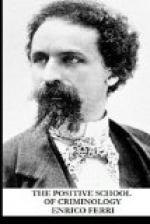Enrico Pessina alone remains of the two giants who concluded the cycle of classic school of criminology. In a lucid moment of his scientific consciousness, which soon reverted to the old abstract and metaphysical theories, he announced in an introductory statement in 1879, that criminal justice would have to rejuvenate itself in the pure bath of the natural sciences and substitute in place of abstraction the living and concrete study of facts. Naturally every scientist has his function and historical significance; and we cannot expect that a brain which has arrived at the end of its career should turn towards a new direction. At any rate, it is a significant fact that this most renowned representative of the classic school of criminology should have pointed out this need of his special science in this same university of Naples, one year after the inauguration of the positive school of criminology, that he should have looked forward to a time when the study of natural and positive facts would set to rights the old juridical abstractions. And there is still another precedent in the history of this university, which makes scientific propaganda at this place very agreeable for a positivist. It is that six years before that introductory statement by Pessina, Giovanni Bovio gave lectures at this university, which he published later on under the title of “A Critical Study of Criminal Law.” Giovanni Bovio performed in this monograph the function of a critic, but the historical time of his thought, prevented him from taking part in the construction of a new science. However, he prepared the ground for new ideas, by pointing out all the rifts and weaknesses of the old building. Bovio maintained that which Gioberti, Ellero, Conforti, Tissol had already maintained, namely that it is impossible to solve the problem which is still the theoretical foundation of the classic school of criminology, the problem of the relation between punishment and crime. No man, no scientist, no legislator, no judge, has ever been able to indicate




